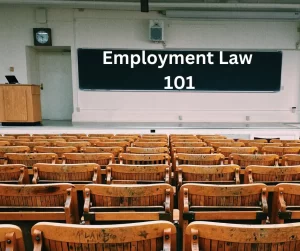
Under Washington State laws and regulations, how does the Washington State Human Rights Commission (WSHRC) progress from complaint to conclusion when processing employment discrimination claims? Here’s my point of view.
(IMPORTANT: This article is for informational purposes only and is based upon my point of view. Due to the rapidly changing nature of the law, we make no warranty or guarantee concerning the accuracy or reliability of the content in this article. No content on this site, regardless of date, should ever be used as a substitute for direct legal advice from your attorney. Please review our Disclaimer | Terms of Use | Privacy Policy before proceeding.)
WSHRC: FROM COMPLAINT TO CONCLUSION
In Washington State, the protection of human rights is a fundamental aspect of ensuring equality and fair treatment for all individuals. The Washington State Human Rights Commission (WSHRC) serves as a vital resource for individuals who believe they have experienced discrimination in various contexts, including employment, housing, and public accommodations, real estate and credit transactions, and insurance. Understanding the process of filing and handling complaints with the WSHRC is crucial for both complainants and respondents involved in these cases. This article will focus on employment discrimination.

I. Filing a Complaint with the WSHRC
1. Initiating the Process:
Complaints can be filed with the WSHRC through an intake call or an in-person interview. See Washington State Human Rights Commission Website, https://www.hum.wa.gov/employment (last visited 2/16/24). The Intake Unit evaluates the jurisdiction of the complaint and may proceed with an intake questionnaire if it falls within the WSHRC’s purview. See id.
NOTE: WSHRC Jurisdictional Criteria
(a) “Employer has at least 8 employees (does not include religious organizations.” Id. (hyperlink added).
(b) “Signed complaints need to be filed within 6 months of last date of alleged discrimination.” Id.
2. Submission of Intake Questionnaire:
Alternatively, individuals can print out and submit the online intake questionnaire. See id. It is essential to ensure that the intake questionnaire reaches the WSHRC within six months of the alleged discriminatory action. See id.
3. Response to Written Charge:
Upon review, individuals may receive a written charge to sign and return to the WSHRC. See id.
4. Assignment to Investigator:
Once the complaint is filed, it is assigned to an investigator for further examination. See id.

II. Responsibilities of Employers Upon Receiving Notice
1. Timely Response:
Employers must send a written response to the charge within 15 days of receiving notice. See id.
2. Position Statement:
They should articulate their position on the alleged unfair actions. See id.
3. Documentation:
Providing relevant documentation to support their response is imperative. See id.
4. Witness Information:
Employers should furnish witness names and contact information as part of the investigative process. See id.

III. Conducting the Investigation
1. Neutral Fact-Finding:
The WSHRC serves as a neutral fact-finder during investigations, tasked with gathering evidence to determine if there is reasonable cause to believe that a violation of the law has occurred. This may involve interviewing witnesses and reviewing pertinent documents. See id.
2. Alternate Dispute Resolution:
The WSHRC encourages the use of alternate dispute resolution methods to resolve complaints efficiently. See id.

IV. Burden of Proof
1. Complainant’s Obligation:
The complainant must present information demonstrating a prima facie case of discrimination. See id.
2. Respondent’s Response:
The respondent can offer non-discriminatory reasons for the actions in question. See id.
3. Additional Evidence:
The burden of proof shifts back to the complainant to provide further information connecting the harm to the protected class. See id.
4. Standard of Proof:
For a finding of reasonable cause, the preponderance of evidence must indicate that discrimination occurred. See id.

V. Conclusion of the Investigation
1. Recommendation to Commissioners:
Following the completion of the investigation, WSHRC staff presents a recommendation to the Commissioners. See id.
2. NO FINDING OF DISCRIMINATION
“If the WSHRC finds no discrimination (no reasonable cause), both parties are contacted with that finding.” Id.
3. Finding of Discrimination:
If the WSHRC determines that illegal discrimination has occurred (reasonable cause), efforts are made to reach a voluntary agreement between the parties. If unsuccessful, the complaint may proceed to a formal hearing before an Administrative Law Judge (ALJ), who can impose significant penalties. See id.
CONCLUSION
Navigating the process of filing and handling human rights complaints in Washington State requires adherence to specific procedures and responsibilities outlined by the WSHRC. By understanding these guidelines, both complainants and respondents can engage effectively in the resolution process, ultimately contributing to the promotion of equality and justice within the state.
READ OUR RELATED ARTICLES
» Definition of Commission (WLAD)
» Remedies for Breach of Conciliation Agreements**
» The Intersection of WSHRC and EEOC**
» The Washington State Human Rights Commission**
» WA State Human Rights Commission Complaints
» WA State Human Rights Commission: Functions, Powers, Duties
» WA State Human Rights Commission: Damages for Humiliation & Suffering**
** (NOTE: This is an external link that will take the reader to our Williams Law Group Blog.)
LEARN MORE
If you would like to learn more, then consider contacting an experienced attorney to discuss your case. This article is not offered as legal advice and will not establish an attorney-client relationship with Law Office of Gregory A. Williams or the author of this article; please refer to our Disclaimer | Terms of Use | Privacy Policy for more information.




